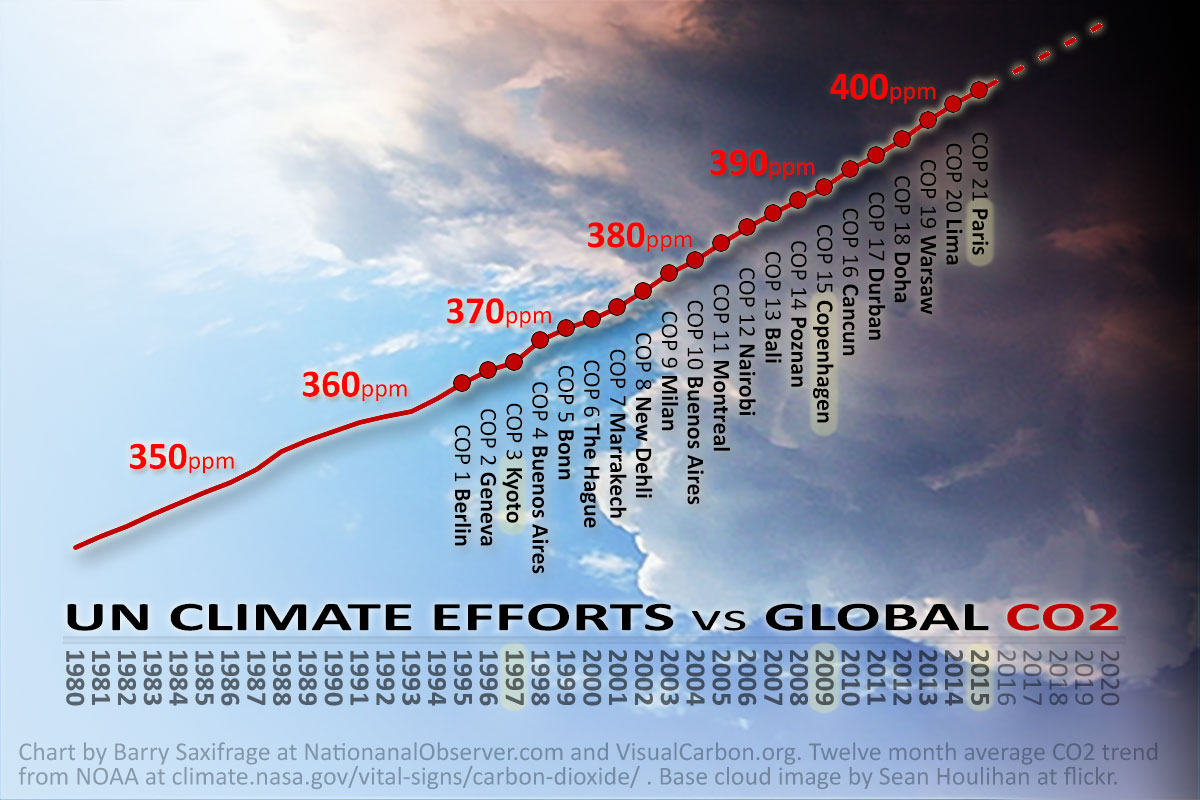Support strong Canadian climate journalism for 2025
The seemingly complicated climate crisis has one very simple yardstick with which to measure progress: the amount of CO2 in the atmosphere.
Carbon dioxide is the primary "control knob" of our climate. The more we put into our atmosphere, the more dangerous our climate crisis will become. The fossil fuel CO2 we've already put is loading our atmosphere, and the climate, with an additional 400,000 atomic bombs worth of extra energy every day.
And now, our turbo-charged climate is starting to bite us. In an attempt to stop the dangerous rise in CO2 levels, the nations of the world have gathered every year for 20 straight years at a United Nations climate conference. My chart below tells you everything you need to know about how effective these global climate efforts have been so far:

The world gathered for the first UN "Conference of the Parties" (COP) back in 1995. That was COP 1 in Berlin. Atmospheric CO2 levels had recently passed the "safe" level of 350 ppm (parts per million), and yet humans were busy dumping an additional 32 billion tonnes of CO2 into our atmosphere each year. Action was clearly needed to change course.
Twenty years and twenty COPs later, however, CO2 levels have risen to over 400 ppm. And humanity now dumps vastly more climate pollution each year – over 45 billion tonnes of CO2.
This month, the world will "try" for the twenty-first time, at COP 21 in Paris.
Will 21 be humanity's lucky number? The world is certainly showing plenty of hopeful signs that our nations, businesses and civil society are finally taking the climate threat far more serious this time. But as my chart makes abundantly clear, it will take something dramatically different than anything we've tried so far to change the score line.
A brief history of CO2 levels
180 to 280 ppm – Homo sapiens. Our species emerged around 250,000 years ago. For the first 99.9 per cent of human existence, CO2 levels stayed below 280 ppm.
240 to 280 ppm – Human civilization. Human civilization developed during a remarkably stable climate period of the last 10,000 years. CO2 levels were around 260 ppm and fluctuated very little. We developed our cities and agriculture in places that made sense in that stable climate. In the last century, however, we began digging up and burning fossil carbon in earnest— billions of tonnes of it a year. By releasing the resulting gigatonnes of CO2 into our atmosphere, we have literally changed the climate.
300 ppm – Around 1950. In a very short time, we managed to crank the climate's "control knob" to its highest level in over 400,000 years.
350 ppm – Our safe long-term level
“If humanity wishes to preserve a planet similar to that on which civilization developed and to which life on Earth is adapted…CO2 will need to be reduced from to at most 350 ppm.” — Dr. James Hansen, former head of NASA's Goddard Institute for Space Studies.
Many climate scientists, such as Dr. Hansen, say that 350 parts per million (ppm) is the maximum that is safe in the long term for humanity. They base this on the dramatic changes that happened on earth the last time CO2 levels were above that level, millions of years ago.
Humanity blew through this 350 ppm guardrail back in 1988. But we still have a small window of opportunity to return to that safe level over the long term, if we rapidly phase out new CO2 pollution while also reducing the CO2 that is already out there via re-forestation and carbon capture technologies.
The nations of the world have not yet agreed to aim for the "safe" level of 350 ppm. However, many nations currently suffering the most from our new climate have started calling for it.
360 ppm – The world exceeded that level in 1995, the year of COP 1 in Berlin.
370 ppm – We blew past this in 2000, the year of COP 6 in The Hague.
380 ppm – This level was passed in 2005, the year of COP 11 in Montreal.
390 ppm – Humans exceeded this in 2010, the year of COP 16 in Cancun.
400 ppm – We've just leapt into the four hundreds this year as the world heads to COP 21 in Paris.
In closing, here's the really big CO2 picture from NASA:







Comments